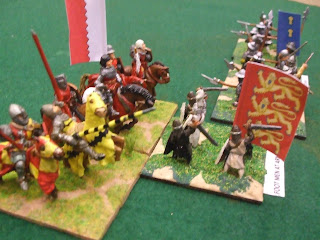The starting positions can be seen below
The Allies, under General, the Lord Montague, are deployed with Brigadier Howard's 4 British battalions on the Wolfsburg to the right of Wilhelmstadt, Von Helsing's Brunswickers covering the town and Von Stalheim's Prussians on the Waldburg to the left. Grenville's cavalry are held in reserve. Wilhelmstadt itself has a garrison of a grenadier battalion.
Marshal Corbiere has his three infantry brigades (left to right, Sully, Montmorency, Givenchy) in the front line with Haut-Provence's cavalry in reserve. Pozieres' fourth infantry brigade will enter via the road leading from the bottom of the photograph.
A roll of the dice allocated command of the Allies to Steve. As Marshal Corbiere, I decided to advance Sully and Montmorency, supported by Haut-Provence, to pin the Allied right and centre. This would leave the six battalions of Givenchy and Pozieres to try and drive off the Prussians and then advance on Wilhelmstadt.
As the French infantry advanced the Allies threw their first spanner into the works of the carefully crafted plan. Von Stalheim ordered his jaegers toward the woods to fire into the flank of Givenchy's advance. Their fire, irritating at first, soon caused the regiment at the right of the line to waver. As the head of Pozieres' column came into view they were greeted by the sight of some of their comrades from Givenchy's brigade retreating. Pozierers quickly ordered his leading battalion to form line and advance on the jaegers and force them to fall back. The jaegers obliged, falling back through the woods and inflicting heavy casualties on their pursuers as they struggled through the trees.
 |
| The Prussian jaeger advance |
In the short melee which followed the infantry held firm and it was the cavalry who fell back, having suffered the loss of almost half their strength. Sensing that further attacks would incur needless casualties, Grenville ordered his men to fall back. He would bide his time and seek further opportunities to attack.
Corbiere now ordered his artillery to concentrate their fire on the allied guns as a prelude to a further advance. This proved surprisingly effective, (due to some rather fortuitous dice rolls) and soon the allied guns were silenced. As Sully and Montmorency continued their advance they diverged and opened up a gap through which Haut-Provence could advance his cavalry. Attempting to bring Grenville's battered command to battle they found themselves denied as the allied cavalry fell back behind Von Helsing's Brunswick infantry.
On the French left Givenchy and Pozieres were struggling to bring the Prussians to battle. Von Stalheim kept his line battalions on the Waldburg, forcing the French to attack him uphill. Meanwhile his jaegers were tormenting Pozieres' infantry , evading contact and sniping away as they fell back. Corbiere's 'right hook' looked to be failing.
In the centre, there was some progress. Montmorency was grinding down the Brunswick battalions defending Wilhelmstadt. Close range artillery fire, supported by volleys from the infantry had reduced two battalions to tatters. Orders were sent to Haut-Provence to complete the job and attack with the cavalry. Inexplicably, nothing happened. The cavalry remained motionless, the Brunswick infantry, perhaps not wishing to antagonise their foe, inflicted only minor casualties with their desultory volleys. A second set of orders were sent, but to no effect.
Meanwhile, Sully had begun his attack on the Wolfsburg. As the French infantry climbed the slopes they were met by devastating volleys from the well-drilled British battalions. Whole companies were swept away and the battered remains of once proud battalions fell back to reform. The disjointed volleys from the French infantry did inflict some losses on the red-coated line, but very little in comparison to the losses they had suffered. In a belated attempt to salvage some French pride, the Commisary General regiment from Haut-Provence's brigade charged in support of the battered infantry. They broke through the 4th Foot and reached the crest of the Wolfsburg, but isolated and unsupported they had to fall back.
Grenville's cavalry had not been idle. Montague had seen the growing strength of the forces attacking the Waldburg and ordered the cavalry to intervene. With the Royal Dragoons in the lead, the Allied cavalry attacked. The French infantry were caught unaware. Their supporting artillery was ridden down and then an infantry battalion suffered the same fate.
 |
| The Royal Dragoons attack the French infantry on the Waldburg |
An enjoyable game, but at times a bit of a struggle as Steve and I tried to remember the rules. We had used them frequently when we gamed with Alasdair several years ago, and when you have thirty or more battalions, (as we often did in those days), losing 3 or 4 is not that significant. With only half that number these rules are quite unforgiving if you have a bit of bad luck with the dice. I will have to try and paint some more 15mm figures or perhaps look for a different set of rules (one that doesn't entail re-basing the figures I already have).












